Sometimes, even the best mattresses don’t do a great job of staying in place. Depending on the materials in a mattress or box spring, you might notice that your mattress shifts around every night or after a few nights of sleep. Or maybe your mattress pad or flat sheet is the moving culprit. No matter which layer of your bed is prone to slipping around, a mattress gripper might be able to help.
Mattress grippers are strips of non-slip material that are just a tad smaller than a mattress. Placing one of these grippers between a mattress and box spring helps prevent a mattress from slipping around on top of the box spring. Similarly, placing a mattress gripper between the mattress and a mattress pad or fitted sheet can help your bedding stay in place so you aren’t having to rearrange it every evening. Sound appealing? Then check out our roundup of best mattress grippers!
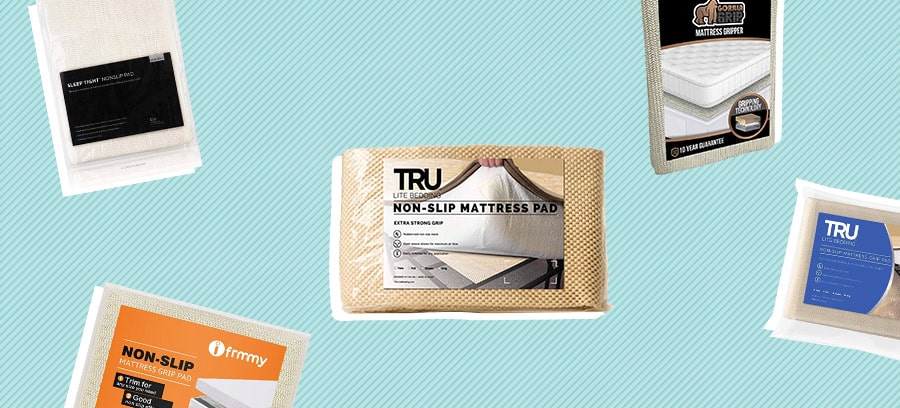
Editor’s Choice
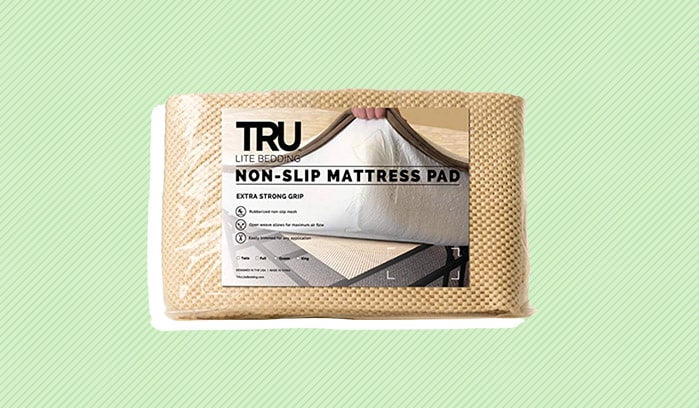
TRU Lite Bedding Extra Strong Non-Slip Mattress Grip Pad
Pros:
- The gripper can be used between a box spring and mattress to hold a mattress in place, or it can be used to hold bedding, bed skirts, or a mattress pad in place.
- The durable mattress gripper is designed to work with even extra-heavy bedding, mattresses, and bed skirts.
- The gripper is trimmable, so it can be customized to the exact size and shape of a mattress.
Cons:
- Compared to other mattress grippers, this one is on the pricier side.
- The gripper might arrive with a strong odor and will need to off-gas before use.
TRU Lite Bedding Non-Slip Mattress Pad (TRU2)
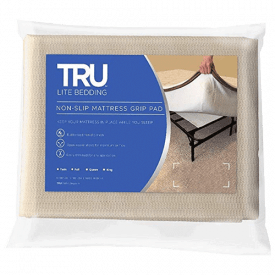
The trimmable TRU Lite Bedding Non-Slip Mattress Pad is made of rubberized open mesh, which is breathable and shouldn’t trap heat. It can be used to hold a variety of items in place, from mattresses to bedding or bed skirts.
Contender
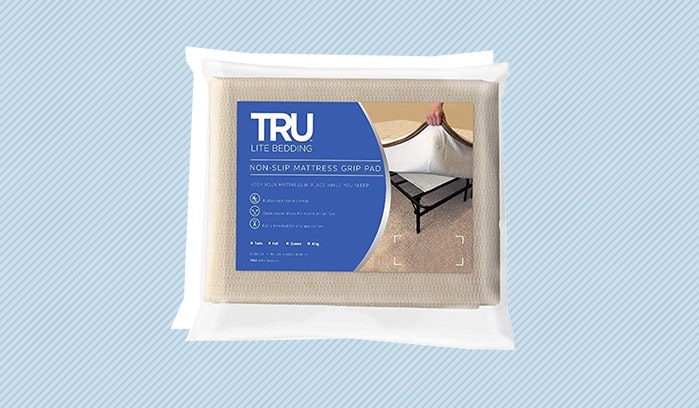
TRU Lite Bedding Non-Slip Mattress Pad
Pros:
- The gripper is trimmable, so it can be fitted to the exact size and shape of a mattress.
- It can be used to prevent a variety of bed-related products from sliding, including mattresses, bedding, and bed skirts.
- The gripper is made of rubberized open mesh that’s fairly breathable and shouldn’t trap heat.
One con? The grippiness could start to degrade over the long-term.
TRU Lite Bedding Non-Slip Mattress Pad (TRU2)

The trimmable TRU Lite Bedding Non-Slip Mattress Pad is made of rubberized open mesh, which is breathable and shouldn’t trap heat. It can be used to hold a variety of items in place, from mattresses to bedding or bed skirts.
Also Consider
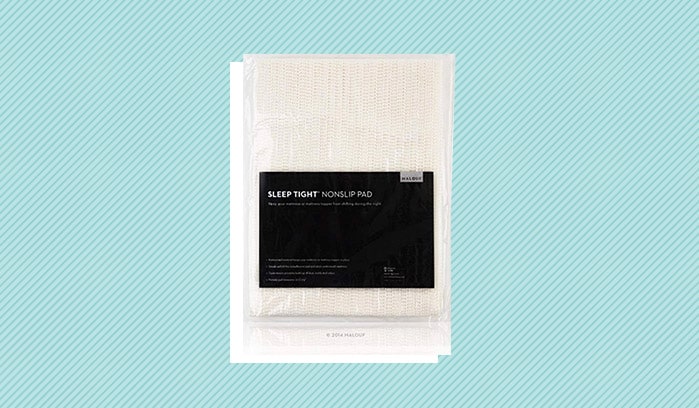
MALOUF SLEEP TIGHT Non-Slip Mattress Grip Pad
Pros:
- The non-slip pad is designed to work with different styles of mattress, box spring, or platform beds.
- The gripper is trimmable, so it can be shaped to the exact dimensions of the mattress in question.
- This is a relatively budget-friendly mattress gripper.
Cons:
- The product might arrive with a strong odor and may need to off-gas before use.
- Foam mattresses might still slip a bit over time.
MALOUF Sleep Tight Non-Slip Mattress Grip Pad
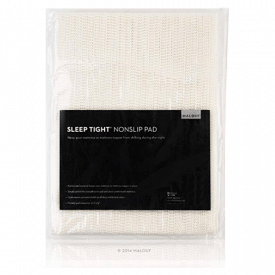
The non-slip MALOUF SLEEP TIGHT Non-Slip Mattress Grip Pad is a relatively budget-friendly mattress gripper. It’s trimmable and can be tailored to the size of the mattress in question.
Honorable Mention
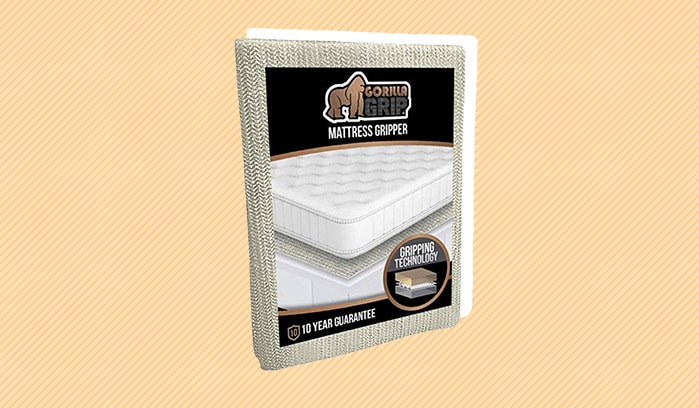
GORILLA GRIP Slip-Resistant Mattress Gripper Pad
Pros:
- The gripper is sold singly or in a set of two. The two-pack offers a significant price break.
- It’s designed to hold even very heavy mattresses in place.
- The gripper comes in all standard mattress sizes and is also trimmable, so it’s easy to achieve a good fit.
One con? The gripper might gradually work less well over the long term.
Gorilla Grip Slip-Resistant Mattress Gripper Pad
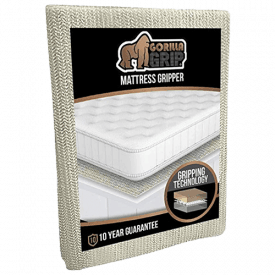
The trimmable GORILLA GRIP Slip-Resistant Mattress Gripper Pad is designed to keep even the heaviest of mattresses from slipping. It’s sold singly or in a set of two, and the two-pack is a very cost-effective option.
Best Bargain
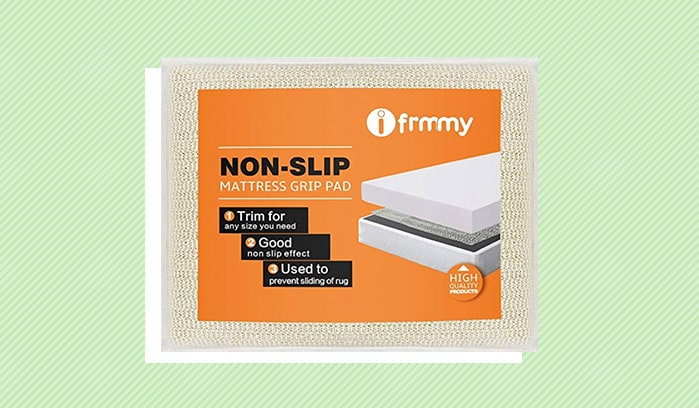
I FRMMY Non-Slip Mattress Gripper
Pros:
- This is a budget-friendly mattress gripper.
- The gripper is made from PVC foam, and one section of the foam is raised and firmer to help ensure a non-slip surface.
- The gripper comes in standard mattress sizes and is also trimmable, so it’s easy to create a good fit.
Cons:
- The gripper might arrive with a strong odor and could need to off-gas before using.
- The gripper might start to work less well over time.
iFRMMY Non-Slip Mattress Gripper
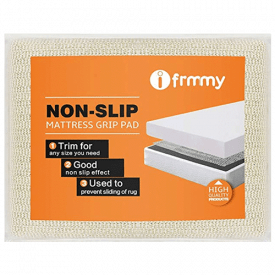
The budget-friendly I FRMMy Non-Slip Mattress Gripper is made from PVC foam, which is raised and hardened in certain areas to create a non-slip surface. The gripper comes in standard mattress sizes and can be trimmed to the perfect fit.
How We Picked
Wondering how we made our selections for best mattress grippers? We used the following criteria to inform our sleuthing.
Functionality and Versatility
These umbrella terms can refer to a number of factors. For instance, some mattress grippers are exclusively meant for use between a mattress and box spring, while others are designed to hold bedding or a bed skirt in place. Some are designed to work with heavier mattresses, while others might not be durable enough to hold heavy beds in place. Some come in the full range of standard mattress sizes, while others are available in fewer sizing options. Some are trimmable, which means you can cut off excess material or shape the gripper to the size of your choosing. We included mattress grippers with a wide range of functions so you can select the best option for your needs.
Sleepopolis Buying Tips
Still trying to settle on the best mattress gripper? Take the following factors into account:
- What’s the intended use for the gripper? Are you trying to prevent a mattress from sliding around, or is the goal to stabilize a bed skirt or mattress pad? If the latter, look for a gripper that is designed to accommodate additional uses beyond holding a mattress in place.
- Do you have a heavy mattress? If the mattress in question is unusually heavy, then it’s important to look for a gripper that’s specifically designed to accommodate heavier weights.
The best mattress grippers eliminate headaches (and reduce the chance of accidents) by holding a mattress in place. Some of these products can also be used to prevent a mattress pad, bedding, or bed skirt from slip-sliding around. While it might take some trial and error to find the best option for you, the effort will be well worth the peace of mind that you’ll gain.
FAQs
What is a mattress gripper used for?
A mattress gripper is a thin sheet of non-slip material that is typically placed between a mattress and box spring to prevent the mattress from sliding around on top of the box spring. In some cases, a mattress gripper might be used for additional purposes such as preventing bedding, a mattress pad, or a bed skirt from sliding around.
How does a mattress gripper work?
Mattress grippers are fairly simple products that are made of a non-slip material (for example, PVC foam). When this material is placed between a mattress and box spring or between a mattress pad and a mattress, for example, it creates friction that helps hold the product in question in place.
Will a mattress gripper prevent bedding from sliding?
The primary purpose of any mattress gripper is usually to hold a mattress in place. But some grippers are also designed to hold other items in place, such as a mattress pad, fitted sheet, or bed skirt. If you’re trying to prevent bedding from sliding around, look for a mattress gripper that is expressly designed for that purpose.
